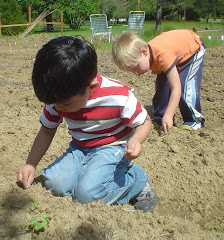One of the benefits of a cool and extended spring season is that the "greens" really thrive. It's time to start harvesting now and this post offers guidelines for harvesting in a "sharing garden".
We are feeling encouraged in this second year of the gardens to see how many people are taking this spirit of sharing to heart. More and more people, from all walks of life, are showing up at the gardens and contributing at the level that feels good to them. For some that means monetary or material donations, for others its actual work in the gardens or behind the scenes and for others their contribution consists of offering kind words of appreciation or by pulling up a garden chair and keeping us company while we weed or mulch the beds. The principle behind the gardens is that "each gives according to ability and receives according to need."
So, back to the questions..."Will there be enough to go around?" - The answer is "Yes, of course," if those of us eating from the garden harvest "according to need". Only harvest what you know you can use and be mindful of the overall quantity of a crop. Currently we have lettuce galore, and much more to come. It's season is short so, if we don't eat it, it will just go to waste. Peas, on the other hand, are in a more limited supply so, if you're picking, try to leave a handful or two for someone else.
"Will there be the kinds of vegetables I like to eat?" In planning a Sharing Garden there are several factors that must come into balance for the garden's success.
Another important function of the Sharing Gardens is to save seed. This adds a layer of local food-security should supply-chains break down. The advantage of having two sites--Monroe and Alpine--is that, for varieties of plants that cross-pollinate (squash for example) we can grow different species in each garden and keep the seed-strains pure. In future years we may call upon those with home-gardens to grow out a row of a particular strain of squash (for example) so we can have a greater variety while keeping the seed-strains pure. This gardener would, of course, have access to the other varieties of squash being grown in other gardens. As we begin to trust the mode of sharing we see that our own needs are met as we care for the needs of the whole group.
We have a link on our website that will have updates on the vegetables that are ready for harvest in each garden. You can click here or go to our website www.AlpineGarden.blogspot.com/ and see the links in upper right-hand corner. Click on "Ripe for Harvest!" for an updated list. When you click on the link, the harvest-list will appear as a blog-post in the upper left-hand corner of the website under the title "Ripe for Harvest!"
Some people, when they first hear about "sharing" gardens feel a little anxious about how it all works out. "Will there be enough to go around?", "Will there be the kinds of vegetables I like to eat?" These are the kinds of questions that might be going through your mind. Most of us, raised in this culture, are taught to "look out for #1", to compete for our own "piece of the pie" and to move through life planning and strategizing for future security at the expense of present time enjoyment and trust that we will be provided for. Sharing Gardens are based on the premise that if we all start taking care of each other as if we are one big family, that there will always be enough to go around and all our needs will be met.Lettuce ready for harvest at Alpine site
We are feeling encouraged in this second year of the gardens to see how many people are taking this spirit of sharing to heart. More and more people, from all walks of life, are showing up at the gardens and contributing at the level that feels good to them. For some that means monetary or material donations, for others its actual work in the gardens or behind the scenes and for others their contribution consists of offering kind words of appreciation or by pulling up a garden chair and keeping us company while we weed or mulch the beds. The principle behind the gardens is that "each gives according to ability and receives according to need."
So, back to the questions..."Will there be enough to go around?" - The answer is "Yes, of course," if those of us eating from the garden harvest "according to need". Only harvest what you know you can use and be mindful of the overall quantity of a crop. Currently we have lettuce galore, and much more to come. It's season is short so, if we don't eat it, it will just go to waste. Peas, on the other hand, are in a more limited supply so, if you're picking, try to leave a handful or two for someone else.
"Will there be the kinds of vegetables I like to eat?" In planning a Sharing Garden there are several factors that must come into balance for the garden's success.
- We aim to grow foods that people are familiar with, and enjoy.
- We choose varieties that are suited to our particular climate and growing season.
- We find a balance of growing foods that can be eaten fresh (lettuce, kale, broccoli, cukes, tomatoes) with those that can be canned/dried/processed for storage (tomatoes, cukes and other pickling vegetables) and root-crops for winter storage (potatoes, squash etc).
So, while everyone's specific and particularly favorite varieties may not be grown, our aim is to meet people's basic food needs. In future years we may be able to develop a level of coordination between people who maintain their own home-gardens whereby someone who has extra space can grow a few rows of something more exotic to share with others involved in the gardens.
Corn seeds saved from previous year's crop
We have a link on our website that will have updates on the vegetables that are ready for harvest in each garden. You can click here or go to our website www.AlpineGarden.blogspot.com/ and see the links in upper right-hand corner. Click on "Ripe for Harvest!" for an updated list. When you click on the link, the harvest-list will appear as a blog-post in the upper left-hand corner of the website under the title "Ripe for Harvest!"
Ripe for Harvest!









































No comments:
Post a Comment